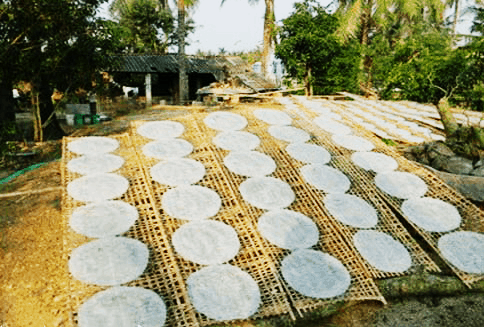Dai Loc is a district located in the north of Quang Nam province, most of the people here are attached to agriculture. The profession of making rice paper in Dai Loc has existed for a long time and created a famous national brand. Dai Loc rice paper is one of the specialties of the homeland, eating a piece can feel the taste and people of Quang.
Dai Loc rice paper is not only to eat, but also a meaningful and precious gift. People in the countryside of Quang Nam often bring rice paper rolls for their loved ones, a gift that is both practical and bold in their homeland. Especially, rice paper is indispensable on the dining table, every tray of Tet holidays. The people of Quang are far from home, remember the rice paper from their homeland must find to buy it, but still lack the fragrant smell of new rice rice, lack the toughness and crunch of Dai Loc rice paper.

Photo: Collectibles
Source: Collected internet.
Eight UNESCO world heritage sites stretch across Vietnam. Each place offers interesting perspectives on local life and majestic natural beauty. The Imperial Citadel and Hue mausoleums take you back to the Nguyen Dynasty full of ups and downs. Hoi An ancient town was once a bustling meeting point for ships and traders around the world. Throughout other provinces and cities, you will encounter ancient relics, poetic scenes, and vivid pieces that create the picture of Vietnamese heritage.
Vietnam is located in the Indomalaya ecological region. According to the 2005 National Environmental Status Report, Vietnam is among the 25 countries with high levels of biodiversity, ranked 16th worldwide in terms of biodiversity and is home to about 16% of the world's biodiversity. species in the world. 15,986 plant species have been found throughout the country, of which 10% are endemic. Vietnam has 307 species of nematodes, 200 species of oligochaeta, 145 species of acarina, 113 species of springtails, 7,750 species of insects, 260 species of reptiles. , 120 species of amphibians, 840 species of birds and 310 species of mammals, of which 100 species of birds and 78 species of mammals are endemic. There are also 1,438 species of freshwater algae, accounting for 9.6% of the total number of algae species, as well as 794 species of aquatic invertebrates and 2,458 species of marine fish. In the late 1980s, a population of Javan Rhinos was discovered in Cat Tien National Park and it is possible that the last individual of this species in Vietnam died in 2010.
The Vietnam National Gene Bank preserves 12,300 varieties of 115 species. The Vietnamese government spent US$497 million to maintain biodiversity in 2004 and has established 126 protected areas including 28 national parks. Vietnam has 2 world natural heritage sites: Ha Long Bay and Phong Nha - Ke Bang National Park and 6 biosphere reserves including Can Gio, Cat Tien, Cat Ba, Kien Giang, and River Delta mangrove forests. Hong and Tay Nghe An.
Vietnam is a country with 54 different ethnic groups, each of which has its own unique and impressive culture and identity. It is this difference in ethnic composition that has contributed to creating a very diverse, rich and unique beauty for Vietnam's culture that no other country can replace. Customs in Vietnam have a long tradition spanning thousands of years, it has become customary law, deep and firmly embedded in the hearts of every Vietnamese person.